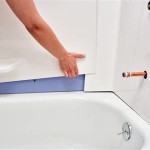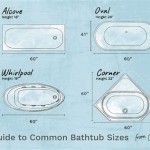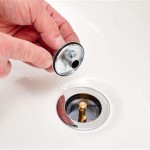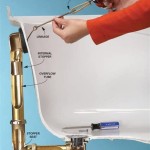How To Effectively Empty Your Bathtub
Efficiently emptying a bathtub is a fundamental aspect of maintaining a functional and sanitary bathroom. A clogged or slow-draining bathtub can lead to unsanitary conditions, unpleasant odors, and potential damage to plumbing systems. Understanding the common causes of bathtub drainage issues and implementing appropriate preventative and corrective measures are crucial for ensuring optimal functionality.
This article provides a comprehensive guide on how to effectively empty a bathtub, covering preventative strategies, troubleshooting techniques, and practical solutions for dealing with various drainage problems. The information provided is designed to empower individuals with the knowledge and skills necessary to address bathtub drainage issues independently, potentially avoiding the need for professional plumbing services.
Preventative Measures: Maintaining Clear Drainage
The most effective approach to ensuring a bathtub empties efficiently is to implement preventative measures that minimize the accumulation of debris within the drain system. These measures primarily focus on preventing common culprits like hair, soap scum, and other foreign objects from entering the drain in the first place.
Using a Hair Catcher: A hair catcher is a simple yet highly effective tool in preventing hair from clogging the bathtub drain. These devices, typically made of plastic or metal mesh, are designed to fit snugly over the drain opening, trapping hair and other debris while allowing water to flow freely. Regular cleaning of the hair catcher is essential to maintain its effectiveness. Ideally, it should be cleaned after each use or at least every few showers. Neglecting to clean the hair catcher will render it ineffective, as the accumulated debris will eventually impede water flow.
Rinsing the Tub After Each Use: Soap scum, a common byproduct of bathing, can gradually accumulate within the drainpipe, contributing to slow drainage and eventual clogs. Rinsing the bathtub after each use helps to minimize the buildup of soap scum. A simple rinse with warm water is usually sufficient. For tubs prone to soap scum accumulation, consider using a non-abrasive cleaner specifically designed for removing soap scum on a regular basis.
Avoiding the Disposal of Foreign Objects: Emphasizing the importance of preventing foreign objects from entering the drain is crucial. Items such as cotton balls, bandages, and small toys can easily get lodged in the drainpipe, causing significant blockages. Educating household members, especially children, about the importance of keeping these items away from the drain is essential for preventing clogs.
Troubleshooting Slow Drainage: Identifying the Cause
When a bathtub experiences slow drainage, the initial step is to identify the underlying cause. A thorough inspection of the drain area can often reveal the source of the problem. Common causes include visible obstructions, such as hair or soap scum, or more subtle issues within the drainpipe itself.
Inspect the Drain Stopper: The drain stopper itself can often be the culprit behind slow drainage. Some stoppers are designed in a way that allows hair and debris to easily accumulate around them. Carefully inspect the stopper for any visible obstructions and remove them as necessary. If the stopper is adjustable, ensure it is properly positioned to allow for optimal water flow. Stopper mechanisms can vary, so consult the manufacturer's instructions if unsure how to adjust or remove it.
Checking for Visible Obstructions: After inspecting the stopper, visually examine the drain opening for any visible obstructions. Hair, soap scum, and other debris can often be seen near the surface. Use a tool such as tweezers or a bent wire hanger to carefully remove any visible obstructions. Exercise caution to avoid pushing the debris further down the drainpipe, which could exacerbate the problem.
Assessing the Overall Drainage Rate: Observe the rate at which the water drains from the bathtub. A consistently slow drainage rate suggests a deeper clog within the drainpipe. If the water drains initially but then slows down significantly, it indicates a partial blockage that restricts water flow. This information is valuable in determining the appropriate course of action for resolving the drainage issue.
Practical Solutions: Clearing a Bathtub Drain
Once the cause of the slow drainage has been identified, implementation of appropriate solutions is necessary to restore optimal drain functionality. Several methods can be employed, ranging from simple DIY techniques to more advanced procedures requiring specialized tools.
Using Boiling Water: For minor clogs, pouring boiling water down the drain can often be an effective solution. The hot water helps to dissolve soap scum and loosen other debris that may be obstructing the drainpipe. Exercise extreme caution when handling boiling water to avoid burns. Slowly pour the boiling water down the drain, allowing it to work its way through the clog. Repeat the process several times if necessary. Note: This method should not be used if you have PVC pipes as the boiling water can damage them.
Employing a Plunger: A plunger is a versatile tool for clearing various types of drain clogs. Ensure there is enough water in the bathtub to cover the cup of the plunger. Create a tight seal around the drain opening with the plunger cup. Vigorously plunge up and down for several minutes, maintaining the seal throughout the process. Remove the plunger to check if the water drains freely. Repeat the process if necessary. If the plunger fails to clear the clog after several attempts, consider trying another method.
Utilizing a Drain Snake (Auger): A drain snake, also known as an auger, is a flexible tool designed to reach deeper into the drainpipe and break up or retrieve clogs. Insert the drain snake into the drain opening, carefully feeding it down the pipe. Rotate the handle of the drain snake to advance it through the drainpipe. When you encounter resistance, it indicates a clog. Continue rotating the handle to break up or dislodge the clog. Once the clog has been cleared, carefully retract the drain snake, removing any debris that has been retrieved. Flush the drain with hot water to ensure it is clear.
Baking Soda and Vinegar Mixture: A mixture of baking soda and vinegar can create a chemical reaction that helps to break down clogs. Pour one cup of baking soda down the drain, followed by one cup of vinegar. Allow the mixture to fizz for approximately 30 minutes. After 30 minutes, flush the drain with hot water. This method is effective for dissolving organic matter, such as hair and soap scum. The fizzing action helps to loosen and break down the clog, making it easier to flush away.
Chemical Drain Cleaners: Chemical drain cleaners are available at most hardware stores and supermarkets. However, it is crucial to use these products with caution, as they can be corrosive and potentially damaging to plumbing systems. Follow the manufacturer's instructions carefully. Wear protective gloves and eyewear when using chemical drain cleaners. Avoid using chemical drain cleaners as a preventative measure, as they can weaken pipes over time. If other methods have failed, consider using a chemical drain cleaner as a last resort.
Removing the Bathtub Drain: In some cases, the clog may be located within the drain assembly itself. Removing the drain assembly allows for direct access to the drainpipe for cleaning. The process for removing the drain assembly can vary depending on the type of bathtub drain. Consult a plumbing guide or online resources for specific instructions on removing your particular type of drain. Once the drain assembly has been removed, carefully inspect it for any obstructions and remove them as necessary. Reinstall the drain assembly and test the drain to ensure it is functioning properly.
Professional Plumbing Services: If all other methods have failed to clear the clog, it may be necessary to seek professional plumbing services. A professional plumber has the expertise and specialized tools to diagnose and resolve complex drainage issues. They can also identify any underlying plumbing problems that may be contributing to the clogs.
Regular maintenance, including using hair catchers and rinsing the tub after each use, is essential for preventing future clogs. By implementing these preventative measures and promptly addressing any signs of slow drainage, individuals can maintain a functional and sanitary bathtub experience. Consulting with a qualified plumber is recommended for persistent or complex drainage issues.

5 Easy Ways To Unclog Bathtub Drain

How To Remove A Bathtub Drain The Home Depot

One Simple Trick To Unclog Your Tub Drain The Creek Line House

How To Unclog Bathtub Drain Pipes And Save 200

Top 5 Tips On How To Unclog A Bathtub Drain Smiley Cleaning

Plumbing How To Drain A Free Standing Bathtub Home Improvement Stack Exchange

How To Remove A Bathtub Drain The Home Depot

Bathtub Won T Drain Quick Solutions To A Common Problem

Hotel Tub Strainer The Solution To Clogged Drains

What S The Fastest Way To Empty A Tub After Bathing Scienceabc
Related Posts








